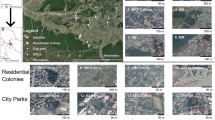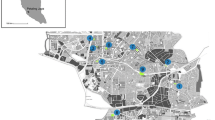Abstract
The urban–rural gradient effect, together with the value of urban green patches, on saving bird diversity has received significant research in recent years. These topics are usually studied in the context of big cities, where the effects are more pronounced. In the present study, we observed how these phenomena affect the avicoenoses in smaller spa town, where landscape protection supports the benefits of biocultural diversity. We assessed the effect of the occurrence of microhabitats (especially particular tree and shrub forms) within the urban–rural gradient on bird fauna composition. We found that the urban–rural gradient in towns is not as relevant as in cities because the effect is covered with a more complicated multi-layered vegetation structure. For the management practices we confirm the high importance of vegetation continuity from the periphery to the city centre, bypassing the isolation of green patches. A proportion of deciduous and coniferous trees and their spatial heterogeneity are important for the occurrence of small songbirds. Next, we conducted a questionnaire-based study with the park visitors and found that there is a biocultural benefit from the presence of songbirds in large urban parks, especially in the spa town. The clear preference of songbirds by park visitors highlights the social benefit of bird diversity.



Similar content being viewed by others
References
Adevi AA, Mårtensson F (2013) Stress rehabilitation through garden therapy: the garden as a place in the recovery from stress. Urban For Urban Green 12:230–237
Andersson E, Bodin O (2009) Practical tool for landscape planning? An empirical investigation of network based models of habitat fragmentation. Ecography 32:123–132
Biadun W, Zmihorski M (2011) Factors shaping a breeding bird community along an urbanisation gradient: 26-year study in medium size city, Lublin, SE Poland. Pol J Ecol 59:381–389
Bibby CJ, Burgess ND, Seddon AJE (1992) Bird census techniques. Academic Press, London
Blair RB, Johnson EM (2008) Suburban habitats and their role for birds in the urban-rural habitat network: points of local invasion and extinction. Landsc Ecol 23:1157–1169
Chace JF, Walsh JJ (2006) Urban effects on native avifauna: a review. Landsc Urban Plan 74:46–69
Croci D, Butet A, Georges A, Aguejdad R, Clergeau P (2008) Small urban woodlands as biodiversity conservation hot-spot: a multi-taxon approach. Landsc Ecol 23:1171–1186
Dallimer M, Irvine KN, Skinner AMJ, Davies ZG, Rouquette JR, Maltby LL, Warren PH, Armsworth PR, Gaston KJ (2012) Biodiversity and the feel-good factor: understanding associations between self-reported human well-being and species richness. BioScience 62:47–55
Dallimer M, Davies ZG, Irvine KN, Maltby L, Warren PH, Gaston KJ, Armsworth PR (2014) What personal and environmental factors determine frequency of urban greenspace use? Int J Environ Res Public Health 11:7977–7992
Donnelly R, Marzluff JM (2006) Relative importance of habitat quantity, structure and spatial pattern to birds in urbanizing environments. Urban Ecosyst 9:99–117
Dorn NJ, Cook MI, Herring G, Boyle RA, Nelson J, Gawlik DE (2011) Aquatic prey switching and urban foraging by the White Ibis Eudocimus albus are determined by wetland hydrological conditions. Ibis 153:323–335
Edwards D, Jay M, Jensen FS, Lucas B, Marzano M, Montangé C, Peace A, Weiss G (2011) Public preferences for structural attributes of forests: towards a pan-European perspective. For Policy Econ 19:12–19
Eeva T, Lehikoinen E (1995) Egg shell quality, nest size and hatching success of the great tit (Parus major) and the pied flycatcher (Ficedula hypoleuca) in an air pollution gradient. Oecologia 102:312–323
Evans KL, Newson SE, Gaston KJ (2009) Habitat influences on urban avian assemblages. Ibis 151:19–39
Fanelli G, Battisti C (2014) Comparing disturbance-sensitivity between plants and birds: a fine-grained analysis in a suburban remnant wetland. Isr J Ecol Evol 60:11–17
Ferenc M, Sedláček O, Fuchs R (2014a) How to improve urban greenspace for woodland birds: site and local-scale determinants of bird species richness. Urban Ecosyst 17:625–640
Ferenc M, Sedláček O, Fuchs R, Dinetti M, Fraissinet M, Storch D (2014b) Are cities different? Patterns of species richness and beta diversity of urban bird communities and regional species assemblages in Europe. Glob Ecol Biogeogr 23:479–489
Fernandes-Juricic E (2004) Spatial and temporal analysis of the distribution of forest specialists in an urban-fragmented landscape (Madrid, Spain) implications for total and regional bird conservation. Landsc Urban Plan 69:17–32
Fontana S, Sattler T, Bontadina F, Moretti M (2011) How to manage the urban green to improve bird diversity and community structure. Landsc Urban Plan 101:278–285
Fuller RA, Irvine KN, Devine-Wright P, Warren PH, Gaston KJ (2007) Psychological benefits of greenspace increase with biodiverzity. Biol Lett 3:390–394
Garaffa PI, Filloy J, Bellocq MI (2009) Bird community responses along urban-rural gradients: does the size of the urbanized area matter? Landsc Urban Plan 90:33–41
Gaston K (2010) Urban ecology. Cambridge University Press, Cambridge
Hessayon DG (2008) The tree and shrub expert. Transworld Publishers, London
Hodgson P, French K, Major RE (2007) Avian movement across abrupt ecological edges: differential responses to housing density in an urban matrix. Landsc Urban Plan 79:266–272
Husté A, Boulinier T (2011) Determinants of bird community composition on patches in the suburbs of Paris, France. Biol Conserv 144:243–252
Husté A, Selmi S, Boulinier T (2006) Bird communities in suburban patches near Paris: determinants of local richness in a highly fragmented landscape. Ecoscience 13:249–257
Isaac B, White J, Ierodiaconou D, Cooke R (2014) Urban to forest gradients: suitability for hollow bearing trees and implications for obligate hollow nesters. Aust Ecol 39:963–972
Jackson AK, Froneberger JP, Cristol DA (2013) Habitat near nest boxes correlated with fate of eastern bluebird fledglings in an urban landscape. Urban Ecosyst 16:367–376
Jensen H, Moe R, Hagen IJ, Holand AM, Kekkonen J, Tufto J, Saether B-E (2013) Genetic variation and structure of house sparrow populations: is there an island effect ? Mol Ecol 22:1792–1805
Jim CY, Zhang H (2013) Species diversity and spatial differentiation of old-valuable trees in urban Hong Kong. Urban For Urban Green 12:171–182
Legendre P, Legendre L (2012) Numerical ecology, 3rd edn. Elsevier, Amsterdam
Lõhmus K, Liira J (2013) Old rural parks support higher biodiversity than forest remnants. Basic Appl Ecol 14:165–173
MacDougall-Shackleton EA, Clinchy M, Zanette L, Neff BD (2011) Songbird genetic diversity is lower in anthropogenically versus naturally fragmented landscapes. Conserv Genet 12:1195–1203
Maffi L (2007) Biocultural diversity and sustainability. The Sage handbook on environment and society. Sage, London, pp 267–278
Maffi L (2014) Biocultural diversity toolkit. Introduction to biocultural diversity, vol. 1. Terralingua, 43p
Major RE, Johnson RN, King AG, Cooke GM, Sladek JLT (2014) Genetic isolation of endangered bird populations inhabiting salt marsh remnants surrounded by intensive urbanization. Anim Conserv 17:419–429
Manuel PM (2003) Cultural perceptions of small urban wetlands: cases from the Halifax reginal municipality, Nova Scotia, Canada. Wetlands 23:921–940
Mathez-Stiefel SL, Boillat S, Rist S (2007) Promoting the diversity of worldviews. In: Haverkort B, Rist S (eds) Endogenous development and bio-cultural diversity. ETC Compas, Leusden, pp 67–81
McCune B, Mefford M (2011) PC-ORD. Multivariate analysis of ecological data. Version 6. MjM Software, Gleneden Beach
Mikula P, Hromada M, Albrecht T, Tryjanowski P (2014) Nest site selection and breeding success in three Turdus thrush species coexisting in an urban environment. Acta Ornithol 49:83–92
Murray CG, Kasel S, Loyn RH, Hepworth G, Hamilton AJ (2013) Waterbird use of artificial wetlands in an Australian urban landscape. Hydrobiologia 716:131–146
Mycko Ł, Rosin Z, Skórka P, Tryjanowski P (2014) Urbanization level and woodland size are major drivers of woodpecker species richness and abundance. PLoS One 9:e94218
Navrátil J, Kučera T et al (2015) Preferences of tourists in their use of the chateau gardens: a Central and Eastern European perspective. J Tour Cult Change. doi:10.1080/14766825.2015.1043919
Nielsen AB, van den Bosch M, Maruthaveeran S, van den Bosch CK (2013) Species richness in urban parks and its drivers: a review of empirical evidence. Urban Ecosyst 17:305–327
Orłowski G, Kasprzykowski Z, Dobicki W, Pokorny P, Wuczyński A, Polechoński R, Mazgajski TD (2014) Trace-element interactions in rook Corvus frugilegus eggshells along an urbanisation gradient. Arch Environ Contam Toxicol 67:519–528
Palomino D, Carrascal LM (2006) Urban influence on birds at a regional scale. A case study with the avifauna of northern Madrid province. Landsc Urban Plan 77:276–290
Pauleit S, Breuste JH (2011) Land use and surface cover as urban ecological indicators. In: Neimelä J (ed) Handbook of urban ecology. Oxford University Press, Oxford, pp 19–30
Pellissier V, Cohenb M, Boulayb A, Clergeau P (2012) Birds are also sensitive to landscape composition and configuration within the city centre. Landsc Urban Plan 104:181–188
Roovers P, Hermy M, Gulinck H (2002) Visitor profile, perceptions and expectations in forests from a gradient of increasing urbanisation in central Belgium. Landsc Urban Plan 59:129–145
Sandström UG, Angelstam P, Mikusinski P (2006) Ecological diversity of birds in relation to the structure of urban green space. Landsc Urban Plan 77:39–53
Schipperijn J, Bentsen P, Troelsen J, Toftager M, Stigsdotter UK (2013) Associations between physical activity and characteristics of urban green space. Urban For Urban Green 12:109–116
Schwartz A, Turbé A, Simon L, Julliard R (2014) Enhancing urban biodiversity and its influence on city-dwellers: an experiment. Biol Conserv 171:82–90
Šmilauer P, Lepš J (2014) Multivariate analysis of ecological data using Canoco 5. Cambridge University Press, Cambridge
Šťastný K, Bejček V, Hudec K (2006) Atlas hnízdního rozšíření ptáků v České republice. Aventinum, Praha
Sukopp H, Numata M, Huber A (1995) Urban ecology as the basis of urban planning. SPB Academic Publishing, The Hague
Sutherland WJ, Newton I, Green RE (2005) Bird ecology and conservation: a handbook of techniques. Oxford University Press, Oxford
ter Braak CJF, Šmilauer P (2012) Canoco reference manual and user’s guide: software for ordination (version 5). Microcomputer Power, Ithaca
Thorington KK, Bowman R (2003) Predation rate on artificial nests increases with human housing density in suburban habitats. Ecography 26:188–196
Townsend M, Weerasuriya R (2010) Beyond Blue to Green: The benefits of contact with nature for mental health and well-being. Beyond Blue Limited, Melbourne
Tremblay MA, St Clair CC (2011) Permeability of a heterogeneous urban landscape to the movements of forest songbirds. J Appl Ecol 48:679–688
Tyrväinen L, Mäkinen K, Schipperijn J (2006) Tools for mapping social values of urban woodlands and other green areas. Landsc Urban Plan 79:5–19
Vaananen VM, Nummi P, Lehtiniemi T, Luostarinen VM, Mikkola-Roos M (2011) Habitat complementation in urban barnacle geese: from safe nesting islands to productive foraging lawns. Boreal Environ Res 16:26–34
Vangestel C, Mergeay J, Dawson DA, Callens T, Vandomme V, Lens L (2012) Genetic diversity and population structure in contemporary house sparrow populations along an urbanization gradient. Heredity 109:163–172
Werquin AC, Duhem B, Lindholm G, Oppermann B, Pauleit S, Tjallingii S (2005) Green structure and urban planning. Final report COST Action C11. ESF COST Luxembourg
Wilde HD, Gandhi KJK, Colson G (2015) State of the science and challenges of breeding landscape plants with ecological function. Hortic Res 2:14069. doi:10.1038/hortres.2014.69
Zhang H, Chen B, Sun Z, Bao Z (2013) Landscape perception and recreation needs in urban green space in Fuyang, Hagzhou, China. Urban For Urban Green 13:44–52
Acknowledgments
We are grateful to P. Šmilauer for statistic consulting. This work was supported by University of South Bohemia (GAJU 04-146/2013/P). We also thank to M. Agnoletti and two anonymous reviewers for their valuable comments.
Author information
Authors and Affiliations
Corresponding author
Ethics declarations
Authors hereby state that they do not have any potential conflicts of interest (financial or non-financial). All human participants undertaking the questionnaire research confirmed the informed consent with the procedure of the research.
Additional information
Communicated by Mauro Agnoletti.
Electronic supplementary material
Below is the link to the electronic supplementary material.
Rights and permissions
About this article
Cite this article
Kučera, T., Kloubcová, P. & Veselý, P. Diverse vegetation in a spa town supports human social benefits of urban birds. Biodivers Conserv 24, 3329–3346 (2015). https://doi.org/10.1007/s10531-015-0974-9
Received:
Revised:
Accepted:
Published:
Issue Date:
DOI: https://doi.org/10.1007/s10531-015-0974-9




